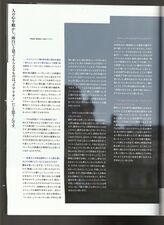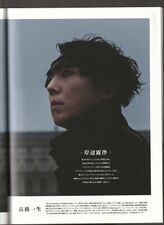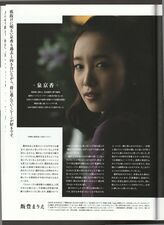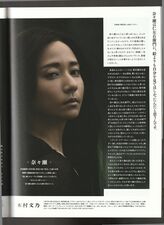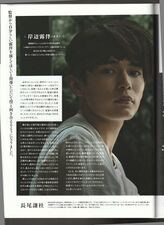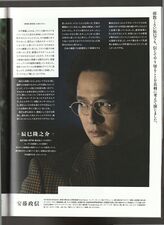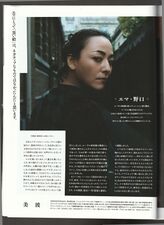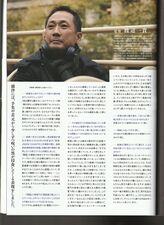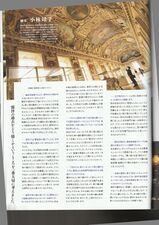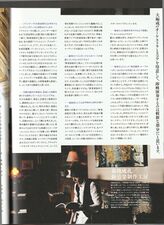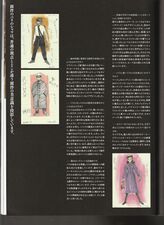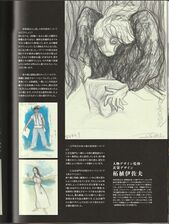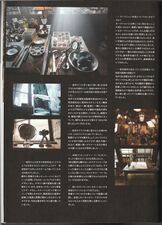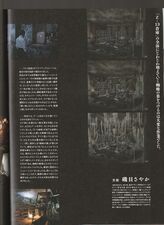Issey Takahashi x GQ (May 2023)
Interview Archive
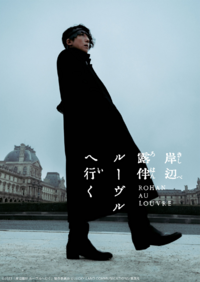
Interviews and commentary from the cast and crew of Rohan au Louvre included in the film's theatrical pamphlet. These include interviews with Issey Takahashi (Rohan Kishibe), director Kazutaka Watanabe, scriptwriter Yasuko Kobayashi, composer Naruyoshi Kikuchi, character designer Isao Tsuge, and production designer Sayaka Isogai, as well as comments from the following actors: Marie Iitoyo (Kyoka Izumi), Fumino Kimura (Nanase), Kento Nagao (young Rohan Kishibe), Masanobu Ando (Ryunosuke Tatsumi), and Minami (Emma Noguchi).
Interviews
Rohan Kishibe: Issey Takahashi
Born December 9, 1980, in Tokyo. He has featured in a wide range of films, TV dramas, and stage productions. His awards include: the 31st Nikkan Sports Film Award for Best Supporting Actor for his roles in the films The Lies She Loved, Recall, and Million Dollar Man (2018); the 45th Kikuta Kazuo Drama Award for the stageplay Shakespeare in Tenpo 12 (2020); and the 29th Yomiuri Prize for Best Actor for NODA MAP's Fakespeare (2021). His recent major roles include Romance Doll (2020), Wife of a Spy (2020), Rurouni Kenshin: The Beginning (2021), Shin Ultraman (2022, voice role), the NHK period drama Naotora: The Lady Warlord (2017), Snow Country (2022, NHK BS Premium), Thus Spoke Kishibe Rohan (2020-2022, NHK), 6-Second Trajectory: The Melancholy of Pyrotechnician Seitaro Mochizuki (2023, EX), and the stage play 2020 (2022). He is scheduled to appear in NODA MAP's 26th performance, A Rabbit, Running on the Waves.
During the first season of the drama, you and director Kazutaka Watanabe apparently talked about a Rohan au Louvre film as a pipe dream.
When I heard about the film adaptation of the original Rohan au Louvre, I was more calm than surprised; the flow leading up to it was, how should I put it, very natural. During filming for the drama's first season, even though the film hadn't been announced, Mr. Kazutaka said to me, "Mr. Issey, could you save that for the Louvre?" Back when he said that, we couldn't afford to count our chickens before they hatched, so it felt like the joke had become a reality.
And what action was he referring to, exactly?
In Episode 2, "Kushagara," I struck a little pose I took from Rohan landing in France in the original Rohan au Louvre, almost like I was hinting at something. I had a lot of fun trying to see how many elements of the original work I could incorporate into the drama, and back then, I never imagined that Au Louvre would be made into a feature film.
Mr. Takahashi, what do you find most important to playing the character of Rohan Kishibe?
As Rohan would say, "reality." But don't get me wrong: "real" and reality are much different. What's real is true, but at the end of the day, we're only creating fiction. I think that what moves people's hearts and makes them find it interesting isn't what's real, but rather the reality of it, its realism. Not what someone else might find true or authentic, but how authentic it is to you. As soon as you doubt whether you find it convincing, it becomes a mere lie.
Whenever I work on a production in entertainment, I always try to act in a way that convinces myself. This film was no different, in that regard. In a period drama, for example, having someone supervise my behavior helps make my performance seem as real as possible. Little things like that are the parts I find convincing. As an actor, I have an inner self supported by my form, and unless I find a good balance between my inner and outer selves, I won't be able to deceive myself.
In this film, your own sins become one of the story's central points.
Even though Rohan has a special power, I don't think he sees himself as a being that transcends humanity. I think Rohan is very human. He just can't help but go wherever his curiosity takes him. He can't control himself, so he's also very childish. But the way he somehow balances everything out is very mature, and I think he strikes a balance between youth and adulthood. He probably knows that his curiosity will cause him to make a mistake someday, and when he faces that mistake, I think he ponders how he'll make amends for it. That said, I think he'd have a hunch as to how it'd come for him. In this film, he has a bit of a hunch from the beginning, and as he remembers his past, I believe he thinks, "Maybe something's about to happen." I think he also ponders "sin."
How did you feel about playing two roles, Rohan and Nizaemon Yamamura?
Filming in Aizuwakamatsu (Fukushima Prefecture) started with Rohan using Heaven's Door on Nanase, and from the next day onward, I was only filming Nizaemon's part. Kazutaka Watanabe, the director, also directed the NHK drama Naotora: The Lady Warlord, so it felt like I was filming a period drama, and sometimes Rohan felt more like a dream. That said, I thought it was nice that, even while I was playing Nizaemon, the feeling of being Rohan suddenly surfaced at some point. If I'd forgotten about Rohan, I think it would've become something completely different. I felt it was good that I was able to come to my senses halfway through, rather than just feeling happy to be doing a period drama with Kazutaka again after so long.
Nanase also has the line, "You're similar."
Rohan and Nizaemon are related by blood, but I thought that if I were to take Nizaemon's character directly from Rohan, it would be wrong of me. There was also a time where Nizaemon existed as just Nizaemon, and Nizaemon never knew Rohan, who was born later. I think Nizaemon was just a human being trying desperately to live as an artist in that era. He must have encountered all sorts of pushback, but he refused to be restrained by the frameworks of Japanese or Western painting styles, but instead explored the possibilities of pure expression. I figured he had that in common with Rohan, at least. As an artist, I acted with a sense of freedom that nothing could restrain.
岸辺露伴 高橋一生
1980年12月9日生まれ、東京都出身。映画、ドラマ、舞台など幅広く活躍。映画「嘘を愛する女」『空飛ぶタイヤ』『億男』(18)で第31回日刊スポーツ映画大賞助演男優賞、舞台「天保十二年のシェイクスピア」(20)で第45回菊田一夫演劇賞、NODA・MAP「フェイクスピア」(21)で第29回読売演劇大賞最優秀男優賞を受賞。近年の主な出演作に『ロマンスドール』(20)、『スパイの妻』(20)、『るろうに剣心 最終章 The Beginning』(21)、『シン・ウルトラマン』(22/声の出演)、NHK大河ドラマ「おんな城主 直虎」(17)、「雪国 -SNOW COUNTRY-」(22/NHK BSプレミアム)、「岸辺露伴は動かない」(20-22/NHK)、「6秒間の軌跡~花火師・望月星太郎の憂鬱」(23/EX)、舞台「2020(ニーゼロニーゼロ)」(22)など。NODA・MAP第26回公演「兎、波を走る」への出演を控えている。
――ドラマシリーズ第1期の頃に演出の渡辺一貴さんと、あくまで夢の話として映画『岸辺露伴 ルーヴルへ行く』の話をしていたそうですね。
原作「岸辺露伴 ルーヴルへ行く」の映画化の話をいただいたとき、それに至るまでの流れが、なんというか、とても自然だったので、驚きというより落ち着いて受け止められました。ドラマシリーズの第1期の撮影時、まだ映画化が決まっているわけではないのに、一貴さんから「一生さん、今のはルーヴルをやるときに取っておいてもらっていいですか?」なんて言われたり。捕らぬ狸の皮算用どころではない時点で話していたので、冗談にしていたことが本当になってしまったという感じではあります。
――そのお芝居というのは具体的には?
何かを予感させるような細かいポーズをドラマの第2話「くしゃがら」の時にしていますが、原作漫画の「岸辺露伴 ルーヴルへ行く」の中でフランスに降り立った露伴のポーズを取り入れたのです。原作の要素をどれだけお芝居の中に取り込めるかと、いろいろ楽しんでやっていて、その時はまさか「ルーヴル」の映画化が実現するとは思っていなかったのですが。
――高橋さんが岸辺露伴という人間を演じる上で大事にしていることはなんですか?
露伴が言っていますが、“リアリティ”です。ただ、勘違いしたくないと思ったのはリアルとリアリティは違うということです。リアルは本当のことですが、僕らはあくまで虚構をやるわけで、人の心を動かしたり、面白いと思ってもらえたりするものはリアルではなくてリアリティ、迫真性だと思うんです。誰かにとっての真実や本当ではなく、自分にとっての本当っぽさです。自分が納得をしているか、していないかに迷いがあると途端に嘘になる。僕は娯楽として作品を成立させる上で、自分で納得するお芝居をいつもやらせていただいています。今回の映画においてもそれは変わることはありませんでした。例えば時代劇では、所作指導の方に入っていただくことによって、どれだけ本当っぽく落とし込んでいくかということにおいて、そういう所作に助けられるところがあります。そういうものが自分を納得させるパーツになるんです。僕という俳優には、形に助けられる内面というものがあって、自分の中で外側にあるものと内側にあるものをバランスよく作らないと自分のことは騙せないのです。
――今作では自分の罪が物語のポイントにもなっています。
露伴は能力を持っていますが、自分自身を、人間を超越した存在と捉えていないと思います。露伴はとても人間味があるのではないかなと。露伴は好奇心が向く方にどうしても近づいていってしまう。抑制が利かないわけですから、ものすごく子供っぽくもあるわけで。それになんとか帳尻を合わせていくところは大人っぽくて、子供と大人のバランスをとっていると思います。彼はその好奇心からいずれどこかで怪我をするであろうことは自分で感じているでしょうし、その怪我に対峙する時に、どう落とし前をつけるかということも考えているような気がします。ですが、それがどういう形で自分に襲いかかってくるかということは、予感しているとは思います。今回の映画においては最初から予感めいているものはあって、自分の過去を思い出していくことによって、「何かが起こり得るかもしれない」ということは考えているし、「罪」に関しても考えるところはあるんだと思います。
――露伴と山村仁左右衛門の1人2役はいかがでしたか?
会津若松市(福島県)での撮影は露伴が奈々瀬にヘブンズ・ドアーをするところから入っていて、その次の日からずっと仁左右衛門パートを撮っていたんです。NHK大河ドラマ「おんな城主 直虎」演出の渡辺一貴さんが監督なので、大河ドラマを撮っている感覚になってしまって、露伴の方が夢みたいに感じることもありました。とはいえ、仁左右衛門を演じながらも、どこかで露伴の感覚が不意に出てくるのはよかったなと思いました。露伴を忘れていたら、完全に別物になってしまっていたと思うので。一貴さんと久しぶりに時代劇をやれて嬉しいという感覚のままでなく、途中で我に返ることができてよかったなと感じました。
――奈々瀬の「あなたは、似ている」というセリフもあるわけですよね。
露伴と仁左右衛門は縁戚関係にはあるのですが、仁左右衛門の性質を露伴から明らかに持ってきてしまうと、なにか違うかなとは思いました。仁左右衛門にも仁左右衛門として存在していた時間があって、後に露伴が生まれるということは、仁左右衛門は知らないわけですから。仁左右衛門は、あの時代に絵師として必死に生きている人間だとは思うんです。様々な確執があったでしょうが、そこで日本画や蘭画といった枠にとらわれず、純粋に表現の可能性を探っていった人なので、そこはどこか露伴に通じるところはあるのではないかなと思って演じていました。絵師としては何ものにもとらわれない自由を感じながらお芝居をしていましたね。
Director: Kazutaka Watanabe
Born in 1969. After joining NHK in 1991, he has worked on several TV dramas. He currently belongs to NHK Enterprises. His major directorial roles include Auditing Firm (2008), Limit -A Criminal Scene 2- (2009), the NHK period dramas Ryomaden (2010) and Taira no Kiyomori (2012), See You at the Funeral (2014), Mare (2015), the NHK period drama Naotora: The Lady Warlord (2017), An Artist of the Floating World (2019), First Childbirth at Age 70 (2020), Only Yesterday (2021), Snow Country (2022), and Thus Spoke Kishibe Rohan (2020-2022). This film marks his feature film debut as a director.
When did you start working toward this film adaptation?
We started preparing little-by-little around two years ago, right after the first season of the Thus Spoke Kishibe Rohan drama ended, but since we were in the middle of the coronavirus pandemic, it was difficult to even survey the location. It seems like the Louvre also had a hard time adjusting its schedule right up to the last minute due to the impact of the coronavirus. The producers negotiated with them tenaciously, but it took a while.
I heard that while filming Snow Country (which airs in April 2022, and also stars Issey Takahashi with Watanabe's direction), you wanted to film in the Mukaitaki inn in Aizuwakamatsu, Fukushima Prefecture, again.
When we were filming Snow Country, the planning process for Rohan au Louvre had already begun. I knew, of course, that one of the most important locations in the story was Rohan's grandmother's old Japanese-style home, which was formerly an inn. As we were filming in Mukaitaki, I began thinking, "Hmm... Is this the place?" I remember talking it over with Mr. Issey on set. It felt as though I'd already surveyed the place in my mind (laughs).
Phrases like "hot spring spa" and "storehouse" that appear in Snow Country also share major connections to Au Louvre, don't they?
That's right. There were so many wonderful places in the Aizu region that we'd scouted for locations in Snow Country but hadn't filmed in yet, so we used several of them for this film, including a storehouse in Kitakata. At first, the people of Aizu seem quiet and reserved, but as we talked to them, their love and pride for their hometown began to surface, and I felt throughout the filming process that they have an overwhelmingly strong passion to them.
As I was conducting interviews in Kitakata, I overheard you and Issey talking it over: is the order in which the characters are attacked by the Black Painting's curse decided as part of the lore?
I asked Araki about the order through his editorial department during the prewriting stage of production, and he answered, "First, your own sins come after you. Then, for those who haven't committed any sins or are unaware that they've committed them, the sins of their ancestors come back to haunt them. That's the lore." In warehouse Z-13, everyone sees at the Black Painting at almost the same time, but following the lore, in the movie, the curse attacks them in the following order: Tatsumi, who's been using Maurice to commit evil deeds until recently; Emma, who carelessly lost Pierre one year ago; Hugo, who is attacked by the sin of his grandfather's arson; and Rohan, who is confronted by Nizaemon's regret and resentment, even though he died in the Edo period.
I think that flow is what I was explaining to Mr. Issey. He was alright with that, but since Rohan saw the painting early, there was a long interval before Nizaemon attacked him. He wanted the curse's presence to be felt little-by-little during that interval. It was Mr. Issey's idea originally, but before Nizaemon appears, I consulted with Mr. Tsuge, the character designer, as to how to express that "the black is gradually encroaching upon Rohan." We decided to have "the black" stain the tips of his fingers, and then gradually seep in from his neck, so we added black makeup little-by-little on set for each shot.
Kyoka also saw Nanase's figure, or in other words, the Black Painting, right?
Kyoka just has that kind of resistance (laughs).
She's invincible, isn't she? (laughs)
We've been hinting at that since season two (laughs).
Beyond the Rohan series, do you have a vision for the kind of films you want to make?
At the risk of being misinterpreted, I think there are two kinds of entertainment. There's the kind of film where, even if you forget all about it tomorrow, it's important that you can enjoy those two hours and feel motivated to do your best tomorrow. And then there's the kind where, even if you don't understand everything when you watch it, it strikes a chord with two people out of 100 and sustains them for the rest of their lives. Of course, I think both kinds are important, but the latter—the kind that strikes a chord with a lot of people—is the ideal. I would like to create works that don't pander to others, have a firm grasp of their own meaning, and continue to challenge people, just like Araki's works do.
監督 高橋一生
1969年生まれ。91年にNHKに入局後、数多くのテレビドラマ作品を手掛ける。現在はNHKエンタープライズに所属。主な演出作品に「監査法人」(08)、「リミット -刑事の現場2-」(09)、NHK大河ドラマ「龍馬伝」(10)、NHK大河ドラマ「平清盛」(12)、「お葬式で会いましょう」(14)、「まれ」(15)、NHK大河ドラマ「おんな城主 直虎」(17)、「浮世の画家」(19)、「70才、初めて産みます~セブンティウイザン。~」(20)、「おもひでぽろぽろ」(21)、「雪国 -SNOW COUNTRY-」(22)、「岸辺露伴は動かない」(20-22)などがある。本作で初めて劇場公開映画の監督を務める。
――映画化に向けては、いつ頃から動き始めていたのでしょうか?
「岸辺露伴は動かない」のドラマシリーズ第1期が終わった直後の2年前ぐらいから少しずつ準備を始めていたのですが、コロナ禍真っ最中だったので、なかなか下見にすら行けないような状況でした。ルーヴル美術館側のスケジュールもコロナの影響で調整がギリギリまで大変だったようです。そのあたりはプロデューサー陣が粘り強く交渉してくれたのですが、時間はかかりました。
――高橋一生さんを主演に、渡辺監督が演出を務めた2022年4月放送の「雪国 -SNOW COUNTRY-」の撮影の際に、福島県会津若松市の旅館、向瀧を再び撮影に使用したいと考えていたとお聞きしました。
「雪国」の撮影の時点ですでに『岸辺露伴 ルーヴルへ行く』の企画は進行していたんです。物語の大事な場所の一つに古い和風建築で元旅館だった露伴の祖母の屋敷が出てくることはもちろん認識していて、向瀧さんで撮影している時に、「あれ……ここなのではないか?」と思い始め……。そのことを現場で一生さんにもお話しした記憶があります。すでに心の下見はしていたって感じです(笑)。
――「雪国」に登場する「温泉場」「蔵」といったワードは、この『ルーヴルへ行く』と少なからず繋がるポイントでもありますよね。
そうですね。会津地方には「雪国」でロケハンをしたものの撮影していなかった素敵な場所がいっぱい残っていたので、喜多方の蔵も含め、今回そこをいくつか使用させていただきました。会津の皆さんは、最初は無口で物静かな印象なのですが、話していくうちに地元への愛情や誇りが湧き出してきて、圧倒されるような強いパッションを持っているというのを撮影を通して感じていました。
――その喜多方での現場を取材していた際に、一生さんと監督が話しているのを耳にしてしまったのですが、「黒い絵」の呪いに襲われる順番というのは設定として決まっているのでしょうか?
順番に関しては事前の脚本作りの段階で荒木(飛呂彦)先生に編集部を通して質問をしていて、先生からのお返事は、「まずは自分の罪が襲ってくる。そして罪を犯していない人、犯した自覚のない人は、過去に遡って先祖の罪が襲ってくる。という設定」ということでした。「Z-13倉庫」では全員がほぼ同時に「黒い絵」の方を見てしまいますが、この設定に倣って映画では、「モリスを使って最近まで悪事を働いていた辰巳」「1年前にピエールを不注意で失ってしまったエマ」「祖父の犯した放火の罪に襲われるユーゴ」「江戸時代に死んだ仁左右衛門の後悔と恨みに襲われる露伴」の順番で呪いに襲われることにしました。この流れを一生さんに説明していたのだと思います。一生さんはこの設定に納得しつつも、早めに絵を見てしまっている露伴に仁左右衛門が襲ってくるインターバルが長いので、その間に呪いの存在を少しずつ感じていきたいということで、これは一生さんのアイデアが基なのですが、仁左右衛門が現れる前に少しずつ露伴に「黒が侵食してくる」表現として、手の先から黒くなり始め、首元からも黒が少しずつ押し寄せて来る、という見せ方を人物デザイン監修の柘植(伊佐夫)さんとも相談しながらしていくことになり、現場ではカットを重ねる度に少しずつ黒メイクを足していきました。
――京香は奈々瀬の姿を、つまりは「黒い絵」を見ていたということになりますよね?
京香はそういう耐性があるという(笑)。
――無敵じゃないですか(笑)。
そのあたりは第2期あたりから前振りしているので(笑)。
――監督は「露伴」シリーズに限らず、こんな作品を撮っていきたいというビジョンはありますか?
誤解を恐れずに言うと、エンターテインメントには2種類あると思っていて。映画なら、たとえ明日忘れてしまったとしても、その2時間を楽しめて明日頑張ろうという気持ちになれるのが大事というものと、観た時点では全て分からないけどそれを観たことで100人のうちの2人の心に突き刺さって、その後の人生の何かの糧になるというもの。もちろん両方大事だと思いますが、後者のようなもの――それがたくさんの人に刺さるのが一番の理想だと思います。荒木先生の作品のように、媚びずに、しっかりと自分の心を持って、チャレンジし続ける作品を作っていきたいと思っています。
Scriptwriter: Yasuko Kobayashi
Born April 7, 1965, in Tokyo. He has written and provided series composition for numerous tokusatsu dramas and anime. He is the original author of the manga Danzai Lock, which is currently being serialized in Kodansha's Comic Days magazine. His main works include the Super Sentai series, the Kamen Rider series, the Garo series, the Attack on Titan series, the JoJo's Bizarre Adventure series, Garo: The Fleeting Cherry Blossom (2018), Dororo (2019), Kakegurui ×× (2019), Touken Ranbu: The Movie (2019), and Thus Spoke Kishibe Rohan (2020-2022, NHK).
Which parts of the original work did you pay particular attention to when writing the script?
It was how to portray Rohan's past. I wanted to show the two past scenes, both Rohan in his youth and his roots in Nizaemon, in an atmospheric way. To do so, I had to portray the character Nanase in an appealing way. Araki made Rohan and Nanase look convincing by drawing them in statue-like poses at the Louvre, but that can't be done in a live-action movie. Rather than adding lines, I decided to remove lines from the original work.
In the original work, her name was "Nanase Fujikura," but it's a key point that her name has changed to simply "Nanase" in the film.
That's right. I couldn't find an answer to the question of, "Why did she use a false name?" The question of what "Fujikura" meant remained, so I left it out because I thought it would work without using it. I had to build up how Nanase felt and why she was there, so I double-checked various things with Shueisha, the original publisher, as I went. I thought it would be best to proceed in a way that would allow viewers to watch smoothly without any questions, so I made some changes from the original work for that purpose.
The "longing" that Rohan had for Nanase in the original work is also missing.
That was also something that was cut from the dialogue. Disregarding the persuasiveness of Araki's drawings, there are some things that can be expressed in live action through pauses and spacing, things that sound strange when you turn it into sound through dialogue. So Director Watanabe and I decided to cut those parts out. At that point, we hadn't decided who would play the role, which was another reason we cut it.
At the end, Rohan says, "That summer was an important part of my past," and I felt his determination to affirm the past and move forward.
Really? That's good. The hardest thing was that, after stopping himself from reading her when she was young, Rohan now reads Nanase, so I was worried people would think, "It's ruined," or "It would have been better if he hadn't read," so we discussed the last scene many times. I think the director wanted a key line. I asked him if it was too cheesy, but he said it was fine.
Nanase's line, "You're similar," is original to the film, and connects Rohan to Nizaemon.
I think the reason Nanase came to Rohan was because she saw something in him that could save Nizaemon, and she sensed something similar between Rohan and Nizaemon. It was also his obsession with painting, and I think it was Nanase's feelings that made her say, "You're similar."
I imagine the part set in the Edo period was particularly difficult to write.
Araki asked us to make it a tragic love story. He was unable to draw that himself due to restrictions on page count, but he felt that there needed to be more to the story than just a man possessed by a mysterious power. I had to portray Nizaemon's obsession with the painting, why he had that grudge, and why Nanase wanted to stop Nizaemon.
The art theft group, including Tatsumi, is an important element of suspense in the movie.
Araki wanted to make the people who were defeated the bad guys. Since it's not a battle manga and instead about pursuing the Black Painting, I thought a suspenseful story about painting thieves and swapping paintings would be best suited for the movie.
The line Kyoka says to Rohan, "I think you look a little bit like Mona Lisa," is a homage to a line spoken by Okuyasu Nijimura in the original Rohan au Louvre.
I thought Issey Takahashi looked more like her than the original Rohan (laughs). The Mona Lisa doesn't have double eyelids, and her face isn't that deeply carved. I decided it would be alright to use the line from the original work (laughs).
脚本 小林靖子
1965年4月7日生まれ、東京都出身。数多くの特撮ドラマやアニメ作品の脚本・シリーズ構成を務める。講談社「コミックDAYS」にて連載中の漫画「断罪六区」で原作を担当。主な作品に「スーパー戦隊」シリーズ、『仮面ライダー』シリーズ、「牙狼〈GARO〉」シリーズ、「進撃の巨人」シリーズ、「ジョジョの奇妙な冒険」シリーズ、「薄墨桜 -GARO-」(18)、「どろろ」(19)、「賭ケグルイ××」(19)、『映画刀剣乱舞』(19)、「岸辺露伴は動かない」(20-22/NHK)などがある。
――脚本を執筆する上で、原作のどの部分を大切に考えていきましたか?
露伴の過去をどう描くかというところですね。若い頃の露伴とルーツである仁左右衛門の2つの過去を雰囲気ある感じで見せられたらいいと。そのためには奈々瀬というキャラクターを魅力的に描かないといけません。荒木(飛呂彦)先生はまるでルーヴルの彫像のようなポーズで露伴と奈々瀬を描くことで説得力を持たせていますが、実写はそういうことはできません。付け足すよりも、原作からセリフを落とす方向にしていきました。
――原作では「藤倉奈々瀬」でしたが、今作では「奈々瀬」に変わっているのもポイントですよね。
そうですね。「なぜ偽名を名乗ったのか?」という部分に対する答えが見つからなくて、「藤倉ってなんだ?」っていう疑問が残ってしまうので、これは言わなくても成立するんではないかというところで省いたんです。奈々瀬がどういう気持ちだったのか、どうしてそこにいたのかを構築していかないといけなかったので、そこは原作の集英社さんにもいろいろ確認しつつ進めていきました。疑問に思わないでスムーズに観てもらえるように進めていくのがいいと思って、その点は原作から少し変えているんですよ。
――露伴が奈々瀬に抱いていた「慕情」という言葉も原作からなくなっている部分です。
そこもセリフから削ったところですね。先生の絵の説得力とは別に、実写では間とか空間で出せるところがあったりするのと、セリフでそれを音にすると変になってしまうこともあるので、監督の渡辺さんとここは削る方向にしましょうということで進めていきました。その時点では演じる俳優さんが誰か決まっていなかったこともあって、削ったところでもありました。
――ラストに露伴が言う「あの夏も僕にとって必要な過去の一つだ」というセリフは、過去を肯定して前に進んでいくというような意志を感じました。
本当ですか、よかったです。若い頃に読むのをやめた奈々瀬を露伴は読むことになるので、「台無しじゃん」とか「読まないのがよかったのに」のように思われてしまうのが一番きついので、ラストシーンは何回も話し合ったところでした。キメのセリフがほしいって、監督の要望だったと思います。「キザ過ぎますかね?」って聞いたんですが、「大丈夫です」っておっしゃっていただいて。
――「あなたは、似ている」という奈々瀬のセリフは、露伴と仁左右衛門を繋ぎ合わせる映画オリジナルですよね。
露伴のもとに奈々瀬がやって来たっていうのはきっと何かこの人が仁左右衛門を救える要素を見出したのであって、奈々瀬は露伴と仁左右衛門に似たものを感じたんだと思うんですよね。それは絵に対しての執着心というところでもあり、その奈々瀬の気持ちを「あなたは、似ている」と言わせたというところだと思います。
――江戸時代のパートは特に執筆が大変だった部分だと想像します。
荒木先生の方から「悲恋にしたい」というご希望がありました。先生としてはページ数の問題もあって描けなかったところで、単に不思議な力に取り憑かれた男ということだけではない何かが必要なんだなというのは感じました。仁左右衛門の絵への執念だったり、どうしてその怨念を持ってしまったのかも描かないといけませんし、奈々瀬が何をもって仁左右衛門を止めたいと思っているのかもそうです。
――辰巳を含めた、美術品窃盗グループは映画の大事なサスペンス要素ですよね。
先生側から、やっつけられる人たちは悪者にしたいという要望があって。バトル漫画ではないですし、「黒い絵」を追う話なので、映画として相応しいのはサスペンス調の絵画泥棒、絵画をすり替える話がいいのではとなったんです。
――京香が露伴に言う「先生ってちょっとモナ・リザに似てません?」は、原作「岸辺露伴 ルーヴルへ行く」で虹村億泰が言っていたセリフのオマージュですよね。
原作の露伴より(高橋)一生さんの方が似てない?と思ったんですよね(笑)。モナ・リザって二重じゃないし、そこまで彫りが深い顔じゃないんですよね。原作にあるセリフを言っても大丈夫だなという判断で(笑)。
Music: Naruyoshi Kikuchi and SHIN-ON-GAK
Born in 1963 in Choshi, Chiba Prefecture. He is a musician and author. In the field of music, he has performed on many stages as a saxophonist, and also works as a band leader, producer, and composer across a wide range of genres, mainly jazz. He also writes essays and critiques, and is active as a radio personality and DJ. His main video and anime works include Pandora's Box (2009), Lupin the Third: The Woman Called Fujiko Mine (2012, NTV), both seasons of Mobile Suit Gundam Thunderbolt (2016-2017), Dynamite Graffiti (2018), and Thus Spoke Kishibe Rohan (2020-2022, NHK). In 2022, he started the guild "SHIN-ON-GAK" alongside his own students.
The drama's main theme, "The Great Interregnum," is also used as this film's ending theme.
The Great Interregnum, which I co-wrote with a member of SHIN-ON-GAK, has been the same main theme from season one all the way through season three of the drama. I removed the bass, piano, and saxophone from my orchestra, Pepe Tormento Azucarar, and turned it into a Latin orchestra consisting of a string quartet, percussion, harp, and bandoneon, with a female Vocaloid playing the role of an opera singer. For the film, in order to adapt it from TV size to the 5.1ch size of the cinema, the first task was to make a large-scale arrangement for the strings and blow them up so they would feel rich in the theater. I prepared a large-scale string score, re-recorded the main theme, and then recorded an improvisation without sheet music with the same arrangement, which I thought was innovative.
The music was created after you watched the finished film, right?
I was surprised that it was a grand story that started from the present, then ventured to both the recent and distant past, but ultimately returned to its roots. So rather than trying to create a sense of unity through music, even as time jumps around and the scenes vary dramatically, I decided to make it something like an omnibus, with music that changes completely for each part and doesn't repeat. For the recent past where a younger Rohan appears, I had the image of an inn where geishas might appear. It's not a bittersweet youth, but rather something terrifying and mysterious, so I decided to edit it by improvising a session of three elements: a shamisen nagauta, an ensemble of gamelan from Indonesian folk music, and electronic noise from an analog synthesizer. This was something that had never been done for the Thus Spoke Kishibe Rohan drama before, so we all played together while watching the film. Combining Japanese music, Southeast Asian folk music, and electronic sounds was a popular technique in the '60s and '70s, and it was interesting to record it as we brought it back to life.
What about the music for the part where Rohan goes to Paris?
One member of SHIN-ON-GAK could write modern French music, so I asked him to compose music for the Paris chapter, and then performed it live. The Paris section has both pleasant and scary parts, so the scary parts are multi-tracked with percussion instruments and improvisations with strings and piano, making it quite colorful. SHIN-ON-GAK also provided many other works as short pieces.
And then the distant past takes us to the Edo period.
To ensure that the impression of the end was consistent, I collaborated with a SHIN-ON-GAK member who graduated from the University of the Arts and could write string music, and we wrote a dramatic string piece in the style of Mahler or Puccini. The idea of using Vocaloid on this piece as well was a response to "The Great Interregnum," in which Vocaloid was used despite the piece starting with acoustic strings. In that way, the Vocaloid serves to tie up loose ends.
What do you keep in mind when composing soundtracks, Mr. Kikuchi?
I always try to maintain a sense of surprise and passion without damaging the ensemble of the work. Also, both classicism and innovation are incorporated, whatever the genre. I get bored if it's all classical music or all innovation, so I always try to include both in everything I do.
What kind of work do you see Rohan au Louvre as, Mr. Kikuchi?
It is truly a joy for a musician to encounter such a high-quality work in all aspects. From the moment I was asked to compose for the drama adaptation, the work's aura was hanging in the air. The air created around the film felt similar. A strong work is one where the director gives off relaxed, confident, and powerful vibes. I had a hunch from the beginning that this would work well, and that I'd come across a fantastic work, so I worked on the drama with the utmost respect for it. The schedule for the film was tight, but if the work's good, I don't mind one bit. In fact, it excites me. It made me wonder what new things I could try, so I really enjoyed it, and I'm quite proud of it. I think it's become one of my signature works in background music, so I'm very grateful for this opportunity.
音楽 菊地成孔/新音楽制作工房
1963年生まれ、千葉県銚子市出身。音楽家/文筆家。音楽の分野においては、ジャズを中心に多岐ジャンルに渡ってバンドリーダー、プロデュース、作曲もこなすサクソフォン奏者として多くのステージに立つ。エッセイや批評の執筆。ラジオパーソナリティ、DJとしても活躍。主な映像・アニメ作品には、『パンドラの匣』(09)、「LUPIN the Third~峰不二子という女~」(12/NTV)、「機動戦士ガンダム サンダーボルト1&2」(16~17)、『素敵なダイナマイトスキャンダル』(18)、「岸辺露伴は動かない」(20-22/NHK)などがある。2022年、自らの生徒と共に、ギルド「新音楽制作工房」を立ち上げ。
――メインテーマ「大空位時代」は今作でもエンディングテーマに使用されています。
ドラマシリーズに関して、メインテーマ曲である「大空位時代」は第1期から第3期まで一緒で、「新音楽制作工房」の1人との共作曲を、私の楽団「ペペトルメント・アスカラール」からベース、ピアノ、サックスを抜いて、弦楽四重奏、パーカッション、ハープ、バンドネオンで出来たラテンオーケストラに、オペラ歌手の体で女性のボーカロイドが入っています。本作では、テレビサイズからシネコンの5.1chサイズに対応させるため、ストリングスを大編成にし、劇場用にリッチにブローアップするということを最初のミッションにしました。大編成の弦楽スコアを用意して、メインテーマを録音し直し、そのまま同じ編成で楽譜なしの即興演奏も録音した、という点では斬新だと思います。
――今回の劇中の音楽は、完成した映画を観てから制作していったということですね。
壮大な物語で、現在と近過去と遠過去から、最終的にはルーツバックするということで驚きました。そこで、時代が飛び、絵面も大きく変わるに際して、音楽で統一感を出すのではなく、敢えて、オムニバスみたいな感じで、音楽をパートごとにガラッと変えて、反復させない。という構えを考えました。青年露伴が登場する近過去に関しては、芸者さんでも出てきそうな旅館のイメージがしたことと、かといって甘酸っぱい青春時代ということでもなく、怖さや幽玄さがあるので、三味線と長唄、インドネシアの民族音楽のガムランのアンサンブルに、アナログシンセサイザーのエレクトロノイズ、という三者を即興でセッションさせて編集することにしました。今までのドラマ「岸辺露伴は動かない」には全くなかったもので、映像を観ながら全員で演奏したんですけど、邦楽と東南アジアの民族音楽と電子音が一緒になるというのは、60~70年代に流行った手法ですが、それを蘇らせるということでレコーディングは面白かったですね。
――露伴がパリに行ってからのパートの音楽についてはいかがですか?
「新音楽制作工房」に、フランスの近現代音楽的な曲が書けるメンバーがいたので、彼を直接指名してパリ編に関する音楽を作曲してもらい、生演奏していきました。パリのパートは楽しいところも、怖いところもあるので、その分怖いところは打楽器だけの多重録音とか、弦やピアノの即興も入ったりしていて、色彩豊かですね。「新音楽制作工房」からは、ショートピースとして、他にも作品を数多く提供しています。
――遠過去としては江戸時代に時代が移ります。
最後に印象がバラつかないように、「新音楽制作工房」の中の、芸大出身で弦楽が書けるメンバーと僕との共作で、マーラーやプッチーニ的な、ドラマティックな曲を弦楽のみで書きました。そこにはまたしてもボーカロイドが乗るというアイデアは、元々アコースティックな弦楽のサウンドなのにボーカロイドが乗っている「大空位時代」への回答、というか、伏線の回収みたいな感じでボーカロイドが入っています。
――菊地さんが劇伴を手がける上で意識していることはなんですか?
驚きと感動を保ち、作品のアンサンブルを壊さないように、ということは常に心掛けています。あとはどんなジャンルであれ、古典性と斬新さを組み込むことです。定番ばかりでも、斬新ばかりでも飽きちゃうので、両方を常にどの作品でも組み込んでいこうとは思っています。
――菊地さんにとって『岸辺露伴 ルーヴルへ行く』はどのような作品になっていますか?
これほど全方面的にクオリティの高い作品に出会うということは音楽家にとって本当に幸せなことです。ドラマ版の企画をいただいた時から、作品のオーラがむんむんと漂ってきていたんですよね。今回もこういうことをやるんだっていうのがむんむんしていた。強い作品というのは監督からのバイブスに余裕や自信があるし、パワーがある。これは上手くいくなと、いい作品に巡り合ったなという予感が最初からありまして、作品にリスペクトしながらドラマ版をやらせて頂いていました。本作はスケジュールもタイトでしたが、作品が良いときつくても苦にならないですし、ワクワクする。どんなことをやってやろうかという気になりますので、非常に楽しめた上に誇りが持てる。僕の劇伴の代表的な作品の一つになっているのではないかと思っているので、いい機会をくださって感謝しています。
Character Design and Costume Design: Isao Tsuge
Born in 1960, in Nagano Prefecture. As a character designer, he comprehensively directs and designs the visuals of the characters in a production. He mainly works with NHK dramas, such as the period dramas Ryomaden (2010) and Taira no Kiyomori (2012), Moribito: Guardian of the Spirit (2015-2018), A Stranger in Shanghai (2019), Thus Spoke Kishibe Rohan (2020-2022), and the period drama What Will You Do, Ieyasu? (2023). His film work includes Departures (2008), 13 Assassins (2010), Shin Godzilla (2016), Tezuka's Barbara (2020), and Shin Kamen Rider (2023). He won the 30th Mainichi Fashion Grand Prix Amiko Kujiraoka Memorial Award in 2012 for his groundbreaking "person design."
What sort of outfit is Rohan wearing at the start of the film?
It's the same outfit carried over from the first season of the drama. I wanted to start with the usual image, so that viewers would easily gain an affinity with Rohan. The costume is symmetrical on a fundamental level, but I designed it to appear asymmetrical through the way he wears it. I hoped to express the kind of true nature within Rohan, the kind of person whose curiosity lands him in unexpected situations, whose extreme honesty somehow comes across as asymmetrical.
What are the key points of Rohan's outfit when he visits Paris?
The shirt is an important point. He wears a black tie, which he passes through a loop inside the stand-up collar. I thought about what an avant-garde way to wear a tie would be, so that the tie wouldn't make him look too conservative, and I created the structure of the shirt from there. The way Rohan wears it is out of place with the context of his previous shirts. But since he's wearing a tie, it was necessary to make it look like his shirt is tucked in. So the color changes to black halfway through. From a distance, it provides the illusion that the shirt is tucked in, but in reality, it is out. I wanted to project Rohan's aesthetic sense, a different perspective from the norm, onto this shirt.
The long black coat is also impactful.
I imagined the streets of Paris and was conscious of how the coat would blend in with that atmosphere. I made it heavy and oversized to convey the image that Rohan doesn't express his true feelings very easily. The theme color of the film is black, and Rohan's image in the series is also black, so the coat follows that theme. I wasn't aware of it during the design stage, but looking back, I felt it had the same presence as the long school uniforms that frequently appear in JoJo's Bizarre Adventure, which I thought was also interesting.
Kyoka's first appearance in the film is at the auction site.
I designed a long, coat-like dress with layers of transparent material. Her appearance in Paris is black and beige, but when I first read the film's script, the first image that came to mind for Ms. Iitoyo was purple. In the film, she has a line that goes something like, "I thought I'd wear something more dressy," so I needed to be able to point out that it was more flashy than the typical lady visiting an auction house. In that sense, purple is a subtly good color. It's an important scene that highlights Kyoka's sense of beauty and personality, so I made it strong enough to have a fashionable feel to it.
What about Kyoka after she arrives in Paris?
It's a contrast between a beige long coat and a short black leather mini-dress. The black dress was originally designed with a front zipper. When we were trying on the costumes, Iitoyo suggested wearing it backward, and I was actually thinking it could use another twist. It looked really cute when she put it on that way, so I decided to use the back zipper. In the third season of the drama, in "Rock-Paper-Scissors Kid," she wears short leather pants and black stockings, so I connected the outfit to that image, albeit at a distance.
Even if it's not exactly sexy, it's a cool side to Kyoka that we've never seen before.
I agree. Personally, I think Rohan and Kyoka's looks pay homage to the relationship in the 1963 film Charade, which starred Cary Grant and Audrey Hepburn. That film was set in Paris, too.
How about the younger Rohan played by Kento Nagao?
Even though it's the same white, it's not the clear white of Mr. Issey's Rohan, but rather an ambiguous, organic off-white layering. I wanted to subtly bring out the humanity of the character, whose outline is still vague. The headband's shape is roughly the same, but Kento's is made of a softer material, so there's a subtle difference between them. I think that, if you compare the young Rohan with the current Rohan, there's a clear difference to what he's achieved at that age.
Nanase wears a dark, glossy black camisole.
You could call it the underlying tone of the film, the tragedy she carries, the ambience that this film consistently displays. I feel that the color black also has an affinity with Mrs. Kimura's aura. After trying out various options, that turned out to be the best choice for the film.
What about Nanase's kimono in the Edo period?
The kimono she wears when she is with Nizaemon was created with the brightest color tone. The color tone changes based on the changing circumstances, such as the situation Nanase is in and the flow of her state of mind.
Please tell us about the key points of Nizaemon's costume.
As with Nanase, the tone of his kimono changes based on the flow of his feelings. At the same time, over the course of the story, he is covered in "ink," an important element of this work. So it was necessary to have a base that effectively visualizes that "erosion." The black erosion is the core of the film, which represents this ominous and sad cause-and-effect. In designing the character of Nizaemon, the theme was finding a way to demonstrate that visually.
人物デザイン監修・衣裳デザイン 柘植伊佐夫
1960年生まれ、長野県出身。「人物デザイナー」として作品中の登場人物のビジュアルを総合的にディレクション、デザインする。主な作品に大河ドラマ「龍馬伝」(10)、大河ドラマ「平清盛」(12)、「精霊の守り人」(15-18)、「ストレンジャー~上海の芥川龍之介~」(19)、「岸辺露伴は動かない」(20-22)、大河ドラマ「どうする家康」(23)などのNHKドラマ。映画に『おくりびと』(08)、『十三人の刺客』(10)、『シン・ゴジラ』(16)、『ばるぼら』(20)、『シン・仮面ライダー』(23)などがある。「人物デザインの開拓」により「第30回毎日ファッション大賞/鯨岡阿美子賞」(12)を受賞する。
――劇中序盤に登場する露伴の衣裳はどのようなものですか?
ドラマシリーズ第1期から引き継ぐ同じコーディネートです。ご覧になるみなさんが露伴像に親和性を抱きやすいよう、いつものイメージから入ろうと思いました。この衣裳の基本はシンメトリーに作られていますが、着こなし方でアシンメトリーに表現し、露伴の中にある一種の本質性、好奇心ゆえに思わぬことに巻き込まれてしまう、極めて真面目であるのにどこかシンメトリーではない人間性が表れるといいなとデザインしました。
――パリに行ってからの露伴の衣裳のポイントはなんですか?
シャツは大切なポイントです。黒いタイをしていますが、スタンドカラーの襟の中がループになっており、そこを通しています。タイ姿によって保守的な精神の持ち主に見えないように、アバンギャルドなタイの仕方とは何かを考え、シャツの構造から作りました。露伴のこれまでのシャツの文脈に則って着せ方はアウトしています。しかし、タイをしますのでシャツをインしているように見せる必要がありました。そこで途中から色を黒に切り替えています。遠目にはシャツをインしているように錯視させて実はアウトしている。「普通の視点とは違う」という露伴の美意識をこのシャツに投影させました。
――黒のロングコートも印象的です。
パリの街並みを想像してその雰囲気への馴染み良さを意識しています。重めでオーバーサイズにしているのは露伴が容易に自分の心を表さないイメージです。この作品のテーマカラーが黒であること、シリーズでも露伴のイメージが黒であることからコートもそれに準じています。デザインの段階では無意識でしたけれども、後から見てみると「ジョジョの奇妙な冒険」に頻出する長ランの雰囲気があるなとも感じて、そこも面白いと思いました。
――京香の今作での初登場シーンはオークション会場になります。
透けた素材のレイヤーで、コートのようなロングワンピースをデザインしました。彼女のパリでの姿は黒とベージュですが、この作品の脚本を初めて読んだ時に、飯豊(まりえ)さんに真っ先にイメージしたのが紫でした。劇中で「もっとドレスっぽいの着てこようと思った」というようなセリフがありますから、一般的にオークション会場へいらっしゃる淑女よりは十分に派手だというツッコミができる必要もありました。そのような意味でも紫は微妙にいい位置の色彩です。京香の美意識や性格を表現する大切なシーンですから、モード系の感じられる強度にしています。
―――パリに着いてからの京香はいかがですか?
ベージュのロングコートと黒の皮のショート丈のミニワンピースというコントラストです。黒いワンピースのデザインは最初フロントジップにしていました。衣裳合わせの時に飯豊さんが後ろ前反対に着たらどうかなとおっしゃって、実は自分も何かもう一つ工夫が欲しいなと思っていたんですね。実際に着るととても可愛くて、そのバックジップを採用しました。ドラマシリーズ第3期の「ジャンケン小僧」の時は、ショート丈の皮のパンツと黒ストッキング姿ですが、そのイメージと遠くで連結させています。
――セクシーまではいかないまでも、今まで見たことのない京香のかっこいい一面ですよね。
そうですね。個人的には63年のケーリー・グラントとオードリー・ヘプバーンの映画『シャレード』のような関係を、露伴と京香のルックにはオマージュしています。あれも舞台はパリでしたね。
――長尾謙社さん演じる青年露伴についてはどうでしょう?
同じ白でも、(高橋)一生さん演じる露伴の明確な白ではなく、曖昧な有機的なオフホワイトの重なりで表現しています。まだ輪郭がフワッとしている人間性をそれとなく出したいなと思いました。ヘアバンドの形はほぼ同じですが素材は謙杜さんの方が柔らかい、そのような微妙な違いがあります。若き露伴と今の露伴でしたら、その年齢で到達している何かは明らかに違うだろうということだと思います。
――奈々瀬は濃艶な黒のキャミソールです。
映画に通底するトーンというんでしょうか。背負っている悲劇性、一貫してこの作品が纏うべき空気感とでもいうのか。黒は木村(文乃)さんの雰囲気との親和性もあったように感じます。さまざまな選択を試した上で本作にはそれがいい落ち着き方でした。
――江戸時代の奈々瀬の着物姿については?
仁左右衛門と一緒にいる頃の着物姿はトーンが一番明るい色に設定しています。奈々瀬の置かれている状況や心境の流れ、変化の文脈によって色のトーンを動かしています。
――仁左右衛門の衣裳のポイントについても教えてください。
奈々瀬と同様に着物のトーンを心境の流れによって変化させています。それとともに時系列によって本作の大切な要素である「墨」を浴びていきますから、その「侵食」を効果的に視覚化するベースである必要がありました。黒の侵食こそこの禍々しく悲しい因果を表す作品の根幹です。仁左右衛門の人物デザイン上それをいかに見せるかに主題を置きました。
Art Director: Sayaka Isogai
Born in 1985. She graduated from Kuwasawa Design School in 2007, having majored in space design. She worked as an art assistant on "Shaking Tokyo," a segment of the Tokyo-set omnibus film Tokyo! (2008) directed by Bong Joon-ho. As an assistant, she studied under production designers Yasuaki Harada and Ayako Hanasaki. She then spent 13 years gaining experience at Nouvelle Vague, a company that produces art for movies, TV shows, and promotional videos. In 2020, she went independent and founded DIOPSIDE. She currently working as a production designer, mainly for commercials, music videos, and graphic advertising. She was the art director for the first three seasons (2020-2022) of Thus Spoke Kishibe Rohan (NHK).
Ms. Isogai, what kind of work do you do as the art director for this film? During the on-site interview, I saw you and several others working as a team.
We start by thinking about the concept of what kind of space each situation in the film should have, then we make proposals based on design drawings and blueprints. After receiving the script, we do research in advance and scout locations to further expand on those images. The art department is divided into departments for scenery, decorations, and props, but for this film I was only really working with 10 people or so.
The study at Rohan's house, where countless plants and sketches are hung as pigments for Rohan to reproduce the world's blackest painting, was overwhelming.
I had the opportunity to interview Professor Tsune Arai, who was in charge of supervising Japanese painting techniques for the film, and together with Director Watanabe, we asked him about what kind of pigments and tools were used in the Edo period. The raw materials used back then were glue from plants, insects, and animals, and we projected things that could be used today.
There was a squid swimming around in the tank next to Rohan's desk.
The director requested that we put a squid in the tank, so we arranged one. But a squid is a delicate creature, very sensitive to stimuli such as shaking and bright lights, so we had a lot of trouble handling it...
I noticed a figure of Hot Summer Martha on set.
I hope that those who have been enjoying the Thus Spoke Kishibe Rohan drama series will be able to see those kinds of small details. I wonder if they'll be able to recognize that the events take place after "Hot Summer Martha" while watching.
Whether or not his pet dog, Bakin, is there is also an important point, right?
I consulted with the director on set about Bakin's future, and we decorated the place with a food bowl and toys for the grown-up Bakin, to make it feel like he was there.
What about the auction site?
I don't know much about auctions, so I went to an auction held in Tokyo and personally researched how it works. I was given a paddle and a catalog on the spot, and since there were works by young artists on display, I raised my paddle and bid on them myself. Surprisingly, the place wasn't very decorated, but it was important to know its general flow nonetheless. We tried to create a sense of luxury that matched the atmosphere of the hotel where the filming took place, without changing its basic structure.
What about the room where the young Rohan stayed in his grandmother's house, which used to be an inn?
It doesn't have much of a lived-in feel, and has a fairly simple design. I think Rohan had similar habits and uses of art materials back then, so we worked backward from Rohan's current study to create it. He's still a budding manga artist, so his tools are completely different, but we added art materials that he would've used when he was younger.
The climax scene at Warehouse Z-13 was filmed at the remains of a quarry in Tochigi.
Since the scene's setting is very important to the film, I researched the state of the warehouses at the Louvre. Even though they were warehouses, they were dark, cave-like ploaces, so I struggled to decide which parts to make seem realistic and which to make fantastical. Once the shooting location was decided, it became relatively easy to imagine, so I talked with the director about the layout, which parts of the location would be suitable for acting, and where the Black Painting should be.
Dampening the set must have been hard work for the whole team...
There was no water supply at the location, so we arranged for a sprinkler truck, and we built a large pool for it to draw water from. Warehouse Z-13 was an underground warehouse, so we tried to convey a damp feeling in the film, but it dried up so quickly that we had to keep watering it... (laughs). We talked about adding the spiderwebs from the original work in three stages, like "A," "B," and "C." However, we figured it'd be better to gradually increase the number of spiderwebs, so we added more little-by-little as we were filming. It got to a level where other staff members said, "Oh, are the spiderwebs multiplying?" We also ran simulations of the materials in advance. There were places high and low where the spiderwebs were difficult to place, so it was hard work.
美術 磯貝さやか
1985年生まれ。2007年、桑沢デザイン研究所スペースデザイン専攻卒業。東京が舞台のオムニバス映画『TOKYO!』(08)のポン・ジュノ監督の一編「シェイキング東京」で美術助手を務める。アシスタントとしてプロダクションデザイナー原田恭明、花崎綾子に師事。映画、TV、PVなどの美術制作を行う会社ヌーヴェルヴァーグで13年間経験を積む。2020年に独立しDIOPSIDEを設立。現在CM、MV、グラフィック広告を中心にプロダクションデザイナーとして活動中。「岸辺露伴は動かない」(NHK)は第1~3期(20~22)を担当。
――磯貝さんは本作の美術担当としてどのような仕事をされているのでしょうか? 現場取材では何人かのチームで動いているのをお見かけしました。
劇中に登場する各シチュエーションをどういった空間にするのか、コンセプトから考えデザインをし、デザイン画や図面を基に提案をしています。台本をいただいてから事前にリサーチをし、ロケハンに行って更にイメージを膨らませます。美術部は大道具や装飾、小道具と部署が細かく分かれているのですが、今回は基本的に10人程で動いていました。
――露伴がこの世で最も「黒い絵」を再現するための顔料として、無数の草木やスケッチが吊るされている露伴邸の書斎は圧巻でした。
本作で日本画技法監修を担当されている荒井経先生に取材をさせていただく機会があり、渡辺(一貴)監督と一緒にみなさんで江戸時代にどんな顔料や道具が使われていたかをお聞きしてきました。植物や虫、動物の膠(にかわ)などが原材料になっていて、現代にあるもので使えそうなものを映し込んでいきましたね。
――露伴のデスクの横に置かれた水槽の中には、イカがスイスイと泳いでいました。
監督から「イカを置きましょう」というリクエストがあり手配したのですが、揺れや強い光など、刺激に弱いデリケートな生き物なので扱いにはかなり苦労しました……。
――現場で「ホットサマー・マーサ」のフィギュアが置かれているのを発見しました。
「岸辺露伴は動かない」のドラマシリーズから続けて楽しんでくださっている方に、そういった細かいところも観ていただけると嬉しいなと思いつつ。「ホットサマー・マーサ」の後の出来事なんだと観てもらえるのかなというのはありますね。
――飼い犬のバキンがいるか、いないかも重要なポイントになってきますよね。
現場でバキンのその後について監督に相談し、成長したバキンのフードボウルやおもちゃを入れて気配を感じる飾りにしていました。
――オークション会場についてはいかがですか?
オークションには詳しくなく知らないことが多かったので、実際に東京で開催されているオークションに行き、どんな風に行われているのかを個人的に取材しました。パドルやカタログをその場でもらったり、若い作家さんの作品が出品されていたので、パドルを上げて落札してみたりもしました。意外と装飾されている場所ではなかったのですが、一通りの流れを知ることが大事ですね。基本形を崩さず、ロケ地になったホテルの雰囲気に合わせて、高級感を出してみました。
――青年露伴が泊まっていた元旅館だった祖母の屋敷の部屋は?
あまり生活感は出さず、わりとシンプルなデザインですね。同じようなクセや画材の使い方があると思うので、今の露伴の書斎から逆算して作っていきました。まだ駆け出しの漫画家なので道具は全然違うんですけど、若い頃に使っていそうな画材を置いたりしていました。
――「Z-13倉庫」のクライマックスシーンは、栃木の採石場跡で撮影されました。
作品の中でも世界観が大事なシーンということで、ルーヴル美術館の倉庫の様子を調べたり、倉庫だけど洞窟のような暗い場所で、どこだったら現実っぽいか、ファンタジー色が強くなってしまわないかという観点で悩みましたね。撮影場所が決まってからは、わりとイメージがしやすかったので、あとはレイアウトだったり、ロケ地となった場所のどこをお芝居ができるようにするか、「黒い絵」はどこにあるのがいいかを、監督と話しながら作っていきました。
――現場では、チーム総出で水を撒いていたのが大変そうでした……。
ロケ地に水道はなく散水車を手配してもらい、大きなプールを作り、そこから水を引いていました。「Z-13倉庫」が地下の倉庫ということで湿った感じを映像で伝えようとしていたのですが、すぐに乾いてしまうので、ひたすら水を撒き続けていましたね……(笑)。原作には「蜘蛛の巣」が張られていて、最初は「A」「B」「C」というように3段階を踏もうという話をしていたんです。でも、意外とじわじわ増えていく方がいいんじゃないかということで撮影しながら少しずつ増やしていきました。ほかのスタッフの方が「あれ、蜘蛛の巣増えたかな?」というくらいのレベルでした。事前に素材のシミュレーションもしましたね。高いところから低いところまで、蜘蛛の巣がつきにくい場所もあったので、それも大変な作業ではありました。
Commentary
Born January 5, 1998, in Chiba Prefecture. Since her debut as an actress in 2012, she has appeared in numerous dramas and movies. She is also active as an exclusive model for Oggi magazine and a regular model for MORE magazine. Her recent major roles include Go Away, Ultramarine (2019), Stare (2020), Remain in Twilight (2021), Love You as the World Ends (2021-2023, NTV), Who Needs True Love? (2022, CX), the NHK morning drama Chimudondon (2022), Octo: Mind Investigator Akari Shinno (2022, NTV), The Tunnel to Summer, the Exit of Goodbyes (2022, voice role), and Thus Spoke Kishibe Rohan (2020-2022, NHK).
The duo of Rohan and Kyoka is still going strong in this film. One of Kyoka's charms is that even though the things she does with good intentions end up going nowhere, she's still hard to hate. She's a character who contrasts with Rohan as she attempts to support him with desperate presentations, even if it feels like she says one good thing out of a hundred. She approaches the heart of the story with a different kind of intuition than Rohan's. Their relationship, in which they complement each other's weaknesses, lives on in this film.
I think the footage shot at the Louvre in Paris captures a mysterious atmosphere beyond human management. The filming in the streets of Paris took place on a slightly cloudy day, but I think we were blessed with good weather: the damp, ominous feeling was perfect for Rohan's world.
In the film, it's revealed that Kyoka's father died when she was five years old, but actually, in the "Millionaire Village" episode of the Thus Spoke Kishibe Rohan drama, it was written in Kyoka's book when Rohan used Heaven's Door on her. No one would ever suspect that the photo she held up when she mentioned the Louvre at the end of "Rock-Paper-Scissors Kid" was actually a photo of her father (laughs).
In the scene where she puts her arm around Emma Noguchi's shoulder, Emma having lost her son, I wanted to portray her kindness and strength in not grieving along with Emma. Even though she's also going through a difficult time, she tries to take a step forward regardless. It's a wonderful scene where Kyoka pats Emma's back with her words. Seeing Minami playing Emma really touched me as well at times, but I held back and continued acting.
It's not just Rohan facing his own past, but Kyoka as well. I like the scene where the innocent and incredibly cheerful Kyoka faces her past and moves forward, and I wanted to play it with care.
泉京香 飯豊まりえ
1998年1月5日生まれ、千葉県出身。2012年の女優デビュー後、数多くのドラマ・映画に出演。「Oggi」専属モデル、「MORE」レギュラーモデルとしても活躍中。近年の主な出演作に『いなくなれ、群青』(19)、『シライサン』(20)、『くれなずめ』(21)、「君と世界が終わる日に」(21-23/NTV)、「恋なんて、本気でやってどうするの?」(22/CX)、NHK連続テレビ小説「ちむどんどん」(22)、「オクトー ~感情捜査官 心野朱梨~」(22/NTV)、『夏へのトンネル、さよならの出口』(22/声の出演)、「岸辺露伴は動かない」(20-22/NHK)などがある。
露伴先生と京香のコンビは今作でも健在で、良かれと思ってやっていることが空回りしながらも、憎めないのが彼女の魅力の一つですよね。露伴先生を支えたくて必死にプレゼンをしながら百に一ついいことを言うような感じだったり、露伴先生とはまた違った直感で物語の核心に迫っていく部分だったりが、露伴先生と対照的なキャラクターで、お互いが自分にはない部分を補っている関係性が今回の作品でも生きています。
パリのルーヴル美術館での撮影は、人間の手には負えない、不思議な空気感が映像にも表れていると思います。薄曇りのパリの街での撮影は、湿っぽくて不穏な感じが“露伴”の世界観にはぴったりで天候にも恵まれていました。
劇中では京香の父が5歳の頃に亡くなっていたことが明らかになりますが、実は、ドラマ「岸辺露伴は動かない」の「富豪村」のエピソードで、露伴先生にヘブンズ・ドアーをされた京香の本にはそのことが書いてあったんです。「ジャンケン小僧」のラストで「ルーヴル美術館」と言いながら掲げていた写真が、実は父の写真だったなんて、誰も気づかないですよね(笑)。
息子を亡くしたエマ・野口の肩を抱くシーンは、自分も本当はつらいことがあるけれど、エマと一緒に悲しむのではなく、一歩前に進もうという京香の優しさと逞しさが見えるように演じられたらと思っていました。京香がエマの背中を言葉でさすってあげるような素敵なシーンですし、実際に美波さんがエマを演じられているのを受けて、私も胸にくる瞬間があったのですが、そこはグッとこらえてお芝居をしていました。
露伴先生だけでなく、京香もまた過去と向き合っています。天真爛漫で、底抜けに明るい京香も過去と向き合いながら、前に進んでいくそのシーンが好きですし、大切に演じたいと思っていました。
Born October 19, 1987, in Tokyo. She began her career as the heroine in Adan (2006), and starred in Hear the Sound of Life (2006) in the same year. Since then, she has appeared in several dramas and movies. Her recent major roles include Reminiscence (2017), Spark (2017), The Scythian Lamb (2017), The Many Faces of Ito (2018), My Retirement, My Life (2018), Iwane: Sword of Serenity (2019), The Fable series (2019, 2021), the NHK period drama Awaiting Kirin (2020), Blue (2021), 99.9 Criminal Lawyer: The Movie (2021), Seven Secretaries: The Movie (2022), and Love Life (2022).
I haven't played many roles like Nanase, who isn't human and whose feet never touch the ground, so it was difficult to give her just the right flavor. Usually, I focus on the lines, but I thought that couldn't be the case this time, so I focused on trying to maintain a good balance with Mr. Takahashi and Mr. Nagao, and on not ruining what the director wanted to portray.
In my scenes with Mr. Nagao, I wondered if I could lead the young Rohan astray—she's not a bad woman, so to speak, but I thought it would be nice if I could do that (laughs). I thought that the way I intereacted with the young Rohan and the way I delivered my lines shouldn't be too pretty. I felt that Nanase was looking beyond the young Rohan, into the past behind that name, and I looked at him with that awareness in mind.
I think Nanase wanted Nizaemon to look at her a little more than the painting. I really liked the scene where Nanase talks to Nizaemon about the painting he made. When Nanase says, "To be honest, I don't think it's a great painting," Nizaemon innocently replies, "I like that about you." At that moment, I felt like he was looking at me. As I acted, I thought it was a lovely scene where she didn't feel left out.
The Heaven's Door scene made me really happy! (laughs). It was like I was part of the story. After so much careful preparation, the day finally arrived, and I was excited during every moment of it. I felt as though I'd become art myself.
To me, Nanase is a floating presence, and even now I don't know whether she's alive or dead, or whether she actually existed or not. I think it's interesting that every viewer sees her differently. If a debate were to arise about whether she's human or a ghost, I think that would be the proper definition of Nanase's existence.
奈々瀬 木村文乃
1987年10月19日生まれ、東京都出身。『アダン』(06)のヒロイン役としてキャリアをスタートさせ、同年の『風のダドゥ』(06)では主演を務める。以降も数多くのドラマ、映画に出演。近年の主な出演作に『追憶』(17)、『火花』(17)、『羊の木』(17)、『伊藤君 A to E』(18)、『体操しようよ』(18)、『居眠り磐音』(19)、『ザ・ファブル』シリーズ(19、21)、NHK大河ドラマ「麒麟がくる」(20)、『BLUE/ブルー』(21)、『99.9-刑事専門弁護士- THE MOVIE』(21)、『七人の秘書 THE MOVIE』(22)、『LOVE LIFE』(22)などがある。
奈々瀬のような人間っぽくない、どこか地に足がついていない感じのお芝居はあまりしてこなかったので、その塩梅は難しかったですね。いつもであれば自分の思いをセリフに乗せるのですが、今回はそこじゃないなと思ったので、なるべく(高橋)一生さんや長尾(謙社)さんとのバランス、監督が描きたいことを壊さないように注力していきました。
長尾さんとのシーンでは、青年露伴を惑わせられるか――ある意味、悪い女じゃないですけど、そうできたらいいなとは思いました(笑)。青年露伴との向き合い方、セリフの投げ方は綺麗事にしてはいけないと思ったんですよね。奈々瀬が見ているのは、青年露伴というよりもその先という名の過去を見ていると思って、そういう意識で彼を見つめていました。
奈々瀬は仁左右衛門に、絵よりももう少し自分を見てほしかったんじゃないかなと思うんです。私は奈々瀬が、仁左右衛門が描いた絵について会話をするシーンがすごく好きで。「正直に申し上げれば良い絵とは思えませぬ」と言う奈々瀬に、仁左右衛門が「お前はそういうところが良い」と無邪気に話してくれるその瞬間は、こっちを向いてくれている気がして。置いてきぼりにされていないような、愛おしいシーンだなって思いながらお芝居をしていました。
ヘブンズ・ドアーのシーンは嬉しかったです!(笑)。作品の仲間に入れたというか。綿密な下準備があってようやく当日を迎えるんですけど、その全ての時間がワクワクしちゃって。自分がアートになったかのような気持ちでしたね。
私にとって奈々瀬は宙に浮いた存在で、この人は生きているのか、死んでいるのか、実在していたのか、していなかったのか、今でも答えを持っていないんですよ。観る方によって観方があるのが面白いのかなって。人間なのか、幽霊なのか、そういう議論が起こったとしたら、それが奈々瀬の存在として正しいんだろうなって思います。
Rohan Kishibe (Young): Kento Nagao
Born on August 15, 2002, in Osaka Prefecture. He is a member of the group Naniwa Danshi, which belongs to Johnny & Associates. Since his debut in Where Have My Skirts Gone? (2019, NTV), he has appeared in several movies and dramas. His major roles include Seiho High School Men's!!! (2020, TX), Younger Boyfriend (2020, ABC), My Neighbor, Chikara (2022, EX), Homestay (2022), Seven Days of a Daddy and a Daughter (2022, TBS), and The Third Finger Offered to a King (2023, TBS).
When it came to creating the character, I expanded the image alongside the director, Kazutaka Watanabe, relying on each and every panel of the original work. Since I already had the mental image of Rohan Kishibe as played by Issey Takahashi, the first thing the director said to me was, "I want you to play Rohan as he is in his youth, without being too conscious of Mr. Issey." Having watched the Thus Spoke Kishibe Rohan drama series as a mere viewer, the director's words allowed me to confront the production in my own way.
The younger Rohan I play certainly has his own personality, but since I'm still a budding manga artist, I thought it would be better to be a little softer than Issey's Rohan, even though he's just as confident. I created the role with his future growth in mind. The director put it best: "I don't want Rohan to appear weak just because he's in his youth. I want you to play him with a dignified core," so I made sure I showed off more of his beautiful backbone. In Thus Spoke Kishibe Rohan, Rohan showed off his manners in the "Millionaire Village" episode, so I took inspiration from the drama series; for instance, I thought it might be best to not sit in the seat of honor.
I also enjoyed my first location shoot in the countryside. I heard from a staff member that the location, Aizuwakamatsu, Fukushima Prefecture, is famous for its horse meat, which happens to be one of my favorites. One day, we happened to finish shooting early, so me and my manager went out to eat some horse meat. We also had sauce katsudon, so we enjoyed the local cuisine very much. The director said the inn we filmed at is beautiful in a different way in the winter, when it's covered in snow, so I'd like to go there in private someday with my family or the other members [of Naniwa Danshi].
If I ever get the chance, I'd like to play Rohan again. I think the experience of playing Rohan will become one of the key points in my life, like a chapter in a movie.
岸辺露伴(青年) 長尾謙杜
2002年8月15日生まれ、大阪府出身。ジャニーズ事務所所属のグループ「なにわ男子」のメンバー。「俺のスカート、どこ行った?」(19/NTV)出演以降、様々な映画やドラマに出演。主な出演作に「メンズ校」(20/TX)、「年下彼氏」(20/ABC)、「となりのチカラ」(22/EX)、「HOMESTAY(ホームステイ)」(22)、「パパとムスメの7日間」(22/TBS)、「王様に捧ぐ薬指」(23/TBS)などがある。
役作りについては、原作の一コマ一コマを頼りに渡辺一貴監督とイメージを広げていきました。高橋一生さんが演じる岸辺露伴のイメージがまずあるので、監督は最初に「そこまで一生さんを意識せずに、長尾くんが青年期をやるからこその露伴を演じてほしい」と言ってくださいました。いち視聴者としてドラマ「岸辺露伴は動かない」シリーズを観てきたからこそ、監督のお言葉をいただいてから、自分なりに作品に向き合うことができました。
僕が演じる青年期の露伴は自分を持っているのは確かなんですが、まだ漫画家になりたてなので、自信はあるけど一生さんが演じる露伴よりかは少し柔らかい方がいいのかなと思い、これから成長していくことも考えて役を作っていきました。監督からは「青年期だからといって弱々しい感じではなく、堂々と芯のある露伴を演じてほしい」とよく言われていたので、より綺麗に背筋を見せることなどに気を付けました。「岸辺露伴は動かない」の「富豪村」のエピソードの中で、露伴はマナーを身につけていたので、座るのは上座じゃない方がいいのかなとか、ドラマシリーズからもヒントを得ながら演じていました。
僕としては初めての地方ロケも堪能させていただきました。ロケ地の福島県会津若松市は僕の好きな馬刺しが有名だということをスタッフの方から聞き、たまたま早めに終わった日に、マネージャーと2人で馬刺しを食べに行ったり、ほかにもソースカツ丼が美味しかったりと、地方ならではの食を楽しみましたね。撮影場所になった旅館は、監督が「冬は雪が積もってまた違った良さで綺麗だ」と言っていたので、いずれはプライベートで、家族だったりメンバーと遊びに行けたらと思います。
もしも、また露伴を演じる機会があるのであれば演じさせていただきたいなとは思います。露伴を演じた経験は、自分の人生においてもポイントになってくるのかなと、映画でいうチャプターのなかの一つになると思っています。
Ryunosuke Tatsumi: Masanobu Ando
Born May 19, 1975, in Kanagawa Prefecture. He made his debut in Takeshi Kitano's Kids Return (1996). He has won the Newcomer of the Year Awards at the 20th Japan Academy Film Prize and the 34th Golden Arrow Award, the Kinema Junpo Best Newcomer Actor Award, and the Best Newcomer Award at the 11th Takasaki Film Festival. Since then, he has also been active as a photographer, mainly in the film industry. His recent major roles include Day and Night (2019), Rurouni Kenshin: The Beginning (2021), The Fable: The Killer Who Doesn't Kill (2021), Voice II: 110 Emergency Control Room (2021, NTV), Thousand and One Nights (2022), and Like a Snake, Like a Dove: The Setting Sun (2022).
To begin with, I was careful about how I would take the French lines into my body and deliver them. I believed I couldn't even begin to play the role of Tatsumi until I reached that stage, so I practiced it with all my heart. I didn't know how to convey sounds in French or how to express the gradations of the emotions, so I asked the French supervisor on set to check the nuances and stresses of my words. I was confused by the French actors' ad-libs during filming, and it was a struggle to switch to and from Japanese, so I had it tough.
Tatsumi is nothing if not shady, isn't he (laughs)? Even when he greets Rohan, Tatsumi leads with poems and jokes, using both French and Japanese, as though he were part of a stageplay. I can't live like that, so I was nearly laughing at him myself. Even if he's a lame, shady guy, I gave Tatsumi's role serious thought as I played him, and I found myself wanting to believe in him to the very end.
Tatsumi also admits his crime, releases himself through confession, and dies shedding tears. But I wanted to let him live as a human being, at least until the end, so that's how I played his death and the film as a whole. I wanted to set him free in the end, and I think it was good that Maurice did him in. I think it was the mistakes he made coming back to him, and that he felt he and Maurice were now even.
During the filming in Japan, I didn't have a chance to eat with the other actors, but in France, my co-stars invited me out to dinner as part of their circle many times. I realized that going out to eat a lot brings out emotions that can also be used in a drama. Due to the coronavirus pandemic, it's been years since I've had a meal with my co-stars. It was a lot of fun.
辰巳隆之介 安藤政信
1975年5月19日生まれ、神奈川県出身。北野武監督『Kids Return キッズ・リターン』(96)でデビューし、第20回日本アカデミー賞新人俳優賞、第34回ゴールデン・アロー賞映画新人賞、キネマ旬報新人男優賞 第11回高崎映画祭最優秀新人男優賞を受賞。以降、映画を中心に写真家としても活動。近年の主な出演作に『デイアンドナイト』(19)、『るろうに剣心 最終章 The Beginning』(21)、『ザ・ファブル 殺さない殺し屋』(21)、「ボイスⅡ 110緊急指令室」(21/NTV)、『千夜、一夜』(22)、『鳩のごとく 蛇のごとく 斜陽』(22)などがある。
まず意識したのは、フランス語のセリフをどういうふうに自分の身体に入れてそれを発するかということでした。その段階にまで行かないと、辰巳という役のスタートラインに立てないと思っていたので、その点をひたすら練習していました。フランス語での音の持っていき方、感情のグラデーションの付け方が分からなかったので、フランス語の監修の先生に現場でも聞きながら、言葉のニュアンスや強弱を確認していきました。撮影ではフランスの俳優陣のアドリブに混乱したり、日本語との切り替えに苦戦してしまったりもして難しかったですね。
辰巳は胡散くささしかないですよね(笑)。露伴との挨拶でもポエムや冗談から入っていって、フランス語と日本語を使い分けて、それもまた全部を辰巳は芝居としているわけで。俺としてはこういう生き方は苦手だから、笑っちゃいそうになったりもするんです。たとえダサくて、胡散くさいやつだとしても、辰巳としての役を信じてやり切るということは真剣に考えて演じていましたね。
辰巳も罪を認めて、懺悔として自分を解放し、涙を流して死んでいくんですけど、最後くらいは人として生きさせてやりたいなと思ったので、そういうふうな死に方、芝居の構築をしていきました。最後は解放してあげたかったし、モリスに殺されてよかったんじゃないかなと思います。してしまった過ちは自分に返ってくると思うし、モリスに対してあいつの中ではプラマイゼロになった気持ちがあると思うから。
日本の撮影では俳優同士で食事をする機会はなかったんですが、フランスでは共演者の方々が何度も俺を輪の中に入れようと食事に誘ってくれました。数回食事に行ったりすることで、芝居においても感情が動き出すっていうこともあるなということは理解できました。コロナ禍もあって共演者と食事なんて何年振りなんだろうって。楽しかったですね。
Born September 22, 1986, in Tokyo. She made her film debut in Battle Royale (2000). Afterward, she appeared in productions led by many of Japan's top directors, including Hideki Noda's Fake Crime and Punishment (2006) and Yukio Ninagawa's Eréndira (2007). In 2014, he was selected as a member of the Agency for Cultural Affairs's Program of Overseas Study for Upcoming Artists, and studied at L'École Internationale de Théâtre Jacques Lecoq in Paris for a year. He is currently expanding his horizons as an actor and artist through international activities. His recent major roles include Vision (2018), Tezuka's Barbara (2020), Minamata (2021), Wind, The Wind, the Storm (2022, NHK BS), and First Love (2022, Netflix).
I'm half-Japanese and half-French, I can speak French, and I love art, so there aren't a lot of roles that resemble me. For that reason, I had a strong desire to play this role, and I was truly overjoyed when I was offered the part.
When playing Emma, I focused on Pierre, who drowned in a pond, as well as Emma's guilt for leaving her child alone in the pond at the park. I thought about what it must've felt like to lose Pierre, and in my mind, I created a series of images of falling to the bottom of the pond, unable to move, maggots crawling up from the feet as they go numb.
I decided that Emma can see Pierre. Emma's duty is handling art as an employee of the Louvre, and I thought of it as her only way out, the only place where she can breathe. But even there, she sees Pierre out of the corner of her eye at random, and she suffers disturbing auditory hallucinations, linking back to the image of the maggots crawling. I practiced the accompanying physical reactions.
Another concern was how I would put Emma's half-Japanese background to good use. She's lived in France for many years, so her Japanese is awkward at times. I tried translating short loanwords like "Louvre" into French, and I checked with director Watanabe each time and adjusted as necessary.
Emma was able to touch Pierre for the first time in Warehouse Z-13, and experience the same drowning that Pierre did—and I think she found some small salvation there. It's as though Emma is finally able to face her past, instead of running away from it. Even if the image of the maggots doesn't 100% disappear, she's able to accept her past to a greater extent. Maybe the Black Painting isn't a negative thing for Emma after all. I wanted to play an Emma with a future, and I felt that it'd be nice if that allowed Emma herself to be saved. I believe she's finally taking a step forward.
エマ・野口 美波
1986年9月22日生まれ、東京都出身。『バトル・ロワイアル』(00)で映画デビュー。その後、野田秀樹演出舞台「贋作・罪と罰」(06)、蜷川幸雄演出舞台「エレンディラ」(07)など、日本を代表する多くの演出家の舞台に出演。2014年、文化庁「新進芸術家海外研修制度研修員」のメンバーに選出され、フランス・パリのジャック・ルコック国際演劇学校に1年在籍。俳優、アーティストとして国際的な活動で視野を広げている。近年の主な出演作に『Vision ビジョン』(18)、『ばるぼら』(20)、『MINAMATA―ミナマタ―」(21)、「風よあらしよ」(22/NHK BS)、「First Love 初恋」(22/Netflix)などがある。
日本とフランスのハーフで、フランス語が話せて、美術が好きという、私自身に似ている役はなかなかないので、「演じたい!」という気持ちは強くあり、お声がけいただいて本当に嬉しかったです。
エマを演じるにあたって重点を置いたことは、池で溺れ亡くなってしまったピエールの存在と、公園の池に我が子を一人残してしまった彼女の罪悪についてです。ピエールを失った感覚というのがどういったものなのかを考えていって、私の中では、ジワジワと痺れるように足先からウジ虫が這い上がってきて、身動きができなくなり、池の底に落ちていくという一連のイメージを作りました。
エマにはピエールが見えているという設定にしました。ルーヴル美術館の職員として美術に携わることがエマにとっての責任であって、それが唯一の彼女の抜け道で、息ができる場所なんだと私は思っていて。それでもふとした時に自分の視界の片隅にピエールが現れて、彼女の中で不穏な幻聴から、ウジ虫が這うというイメージに繋がっていく。それに付随した身体の反応を練習していきました。
もう一つは、ハーフという設定の活かし方です。長年、フランスに住んでいるエマは、日本語が時々たどたどしかったり、「ルーヴル」や、細かい外来語をフランス語にしてみたり、その都度、渡辺(一貴)監督に確認して調整しました。
エマは「Z-13倉庫」で初めてピエールに触れることができて、溺れるというピエールと同じ体験ができた――何かそこに救いがあったのだと思っています。エマは過去から逃げるのでなく、向き合えたんじゃないかと。ウジ虫のイメージが100%なくならなくても、過去をだいぶ受け入れられるようになった。エマにとって「黒い絵」は、決してネガティブなものではなかったんじゃないかな。私は未来のあるエマを演じたかったですし、エマ自身がそれで救われたらいいなという気持ちでした。彼女は一歩進めたんじゃないかなと思っています。
